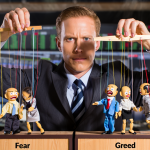
Editor: Philip Ragner | Tactical Investor
What is a Goldilocks Economy? Perfect Balance in an Imperfect World
Aug 15, 2024
Introduction: A Delicate Balance on the Edge of Chaos
In economic theory, the Goldilocks Economy is a compelling ideal – a state where growth, inflation, and employment align perfectly. Much like the porridge in the fairy tale, this economic sweet spot is neither too hot nor too cold. It promises prosperity without the volatility that often accompanies rapid expansion or contraction. Yet, beneath this veneer of stability lurks a precarious balance that can easily tip into chaos if human nature’s baser instincts take hold.
The Allure of ‘Just Right’
A Goldilocks Economy is characterized by steady GDP growth, low unemployment, and inflation that hovers around the central bank’s target rate. This economic nirvana creates an environment where businesses can plan confidently, consumers can spend without fear, and governments can focus on long-term policies rather than short-term crisis management.
Consider the U.S. economy in the late 1990s. GDP growth averaged 4% annually, unemployment dipped below 4%, and inflation was around 2%. This period of sustained growth and stability seemed to validate the idea that careful economic management could produce a perpetual state of prosperity.
However, the very conditions that create a Goldilocks Economy can sow the seeds of its destruction. As stability breeds confidence, confidence can breed complacency, and complacency can breed excess. This is where the dangers of mass psychology rear their ugly head.
The Herd Mentality: When Goldilocks Meets the Wolf
The bandwagon effect and lemming theory explain how rational individuals can collectively make irrational decisions. In a Goldilocks Economy, the prevailing sentiment becomes one of optimism. Investors pile into assets, believing prices will continue to rise. Consumers take on debt, confident in their future earning potential. Businesses expand aggressively, assuming demand will always increase.
This herd mentality can quickly transform a stable economy into a bubble economy. The dot-com boom of the late 1990s exemplifies this phenomenon. As tech stocks soared, investors abandoned caution, pouring money into companies with little revenue and no clear path to profitability. The subsequent crash wiped out trillions in market value and ended the Goldilocks period of the 1990s.
The Greed Factor: When ‘Just Right’ Isn’t Enough
Greed acts as a powerful accelerant to the forces of mass psychology. In a Goldilocks Economy, the temptation to push for more – growth, profit, leverage – becomes irresistible. This is where the carefully balanced economic porridge can quickly become scalding hot.
The 2008 financial crisis provides a stark illustration of this dynamic. Years of stable growth and low interest rates have created an environment where financial institutions took increasingly significant risks, packaging subprime mortgages into complex financial instruments. Homebuyers, caught up in the frenzy, took on mortgages they couldn’t afford. When the music stopped, the global economic system teetered on the brink of collapse.
Contrarian Data Synthesis: A New Approach to Economic Equilibrium
We need a new approach to navigate the treacherous waters between stagnation and excess. Enter Contrarian Data Synthesis (CDS), a methodology that combines sceptical analysis with big data processing to identify economic imbalances before they reach critical mass.
CDS operates on three principles:
1. Question prevailing narratives
2. Analyze vast datasets for hidden patterns
3. Synthesize contrarian viewpoints with empirical evidence
By applying these principles, CDS can act as an early warning system for economic instability. For instance, CDS analysis might have identified the growing risks in the housing market before 2008 by correlating rising home prices with stagnant wages, increasing mortgage debt, and loosening lending standards.
The Power of Ancient Wisdom in Modern Economics
The concept of economic balance is not new. Ancient thinkers grappled with similar prosperity, greed, and societal stability issues. By examining their insights, we can gain valuable perspective on our modern economic challenges.
Croesus, the legendary king of Lydia, learned the hard way that vast wealth does not guarantee lasting prosperity. His defeat at the hands of the Persians serves as a cautionary tale against hubris and overconfidence in times of plenty.
King Solomon’s proverbs on wealth and wisdom offer timeless advice on the virtues of moderation and the dangers of excess. His teachings emphasize the importance of long-term thinking over short-term gains, a lesson often forgotten in the heat of economic booms.
Akbar the Great’s policies of religious tolerance and economic reform in Mughal India demonstrate how inclusive growth can create lasting stability. His approach to governance shows that a Goldilocks Economy is not just about numbers but about creating a society where all can prosper.
Implementing CDS: From Theory to Practice
Applying Contrarian Data Synthesis requires a shift in how we approach economic analysis and decision-making. Here are key strategies for implementation:
1. Develop diverse data sources: Integrate traditional economic indicators with alternative data streams, such as social media sentiment, satellite imagery of economic activity, and real-time consumer spending patterns.
2. Foster a culture of constructive scepticism: Encourage analysts and decision-makers to challenge assumptions and seek out contrary evidence.
3. Utilize advanced analytics: Employ machine learning algorithms to identify subtle correlations and potential leading indicators of economic imbalances.
4. Create cross-disciplinary teams: Combine economists with data scientists, psychologists, and historians to bring multiple perspectives to economic analysis.
5. Implement adaptive policies: Design economic policies that can quickly adjust to changing conditions identified by CDS analysis.
The Path Forward: Balancing Growth and Stability
A true Goldilocks Economy is not a static state but a dynamic equilibrium. It requires constant vigilance and adjustment to maintain. By incorporating the principles of Contrarian Data Synthesis and heeding the wisdom of historical thinkers, we can strive for sustainable prosperity while guarding against the excesses that lead to economic crises.
The challenge lies not in achieving perfect balance but in creating systems resilient enough to withstand the inevitable fluctuations of human behaviour and market forces. As we move forward, our goal should be to build an economic framework that can absorb shocks, adapt to changes, and provide opportunities for all members of society to thrive.
In this pursuit, we must remember that economics is not just about numbers and models. It’s about human behaviour, societal values, and our choices collectively. By staying grounded in this reality, we can work towards an economy that is not just ‘just right’ for a moment but sustainably prosperous for future generations.










